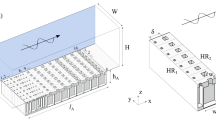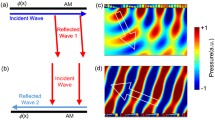Abstract
Effective broadband duct sound propagation control is highly required in many practical engineering applications. In this study, a compact structure constituted by multiple detuned resonators is proposed for broadband duct noise transmission control. The coupling characteristics of two detuned resonators flush-mounted on the sidewall of a duct are firstly investigated. Results show that a coherent perfect absorption (CPA) is induced when these two resonators are precisely designed. Meanwhile, a nearly flat transmission forbidden band is formed, which is very beneficial for duct noise control. Furthermore, it is found that the appearance of the forbidden band is insensitive to the distance between resonators. On this basis, a customized broadband CPA-based structure constructed by detuned resonators is developed, in which the geometric parameters of each adjacent resonator satisfying the CPA condition and the resonators are closely placed. By overlap** the forbidden band of adjacent resonators, a broad duct sound transmission forbidden band is attained. The acoustic performance of the proposed compact design is demonstrated experimentally.











Similar content being viewed by others
References
Červenka, M., Bednařík, M., Groby, J.P.: Optimized reactive silencers composed of closely-spaced elongated side-branch resonators. J. Acoust. Soc. Am. 145(4), 2210–2220 (2019)
Ingard, U.: On the theory and design of acoustic resonators. J. Acoust. Soc. Am. 25(6), 1037–1061 (1953)
Červenka, M., Bednařík, M.: Optimized reactive silencers with narrow side-branch tubes. J. Acoust. Soc. Am. 144(4), 2015–2021 (2018)
Chen, K., Chen, Y., Lin, K., Weng, C.: The improvement on the transmission loss of a duct by adding Helmholtz resonators. Appl. Acoust. 54(1), 71–82 (1998)
Sugimoto, N., Horioka, T.: Dispersion characteristics of sound waves in a tunnel with an array of Helmholtz resonators. J. Acoust. Soc. Am. 97(3), 1446–1459 (1995)
Seo, S.H., Kim, Y.H.: Silencer design by using array resonators for low-frequency band noise reduction. J. Acoust. Soc. Am. 118(4), 2332–2338 (2005)
Munday, J., Bennett, C.B., Robertson, W.: Band gaps and defect modes in periodically structured waveguides. J. Acoust. Soc. Am. 112(4), 1353–1358 (2002)
Richoux, O., Maurel, A., Pagneux, V.: Disorder persistent transparency within the bandgap of a periodic array of acoustic Helmholtz resonators. J. Appl. Phys. 117(10), 104902 (2015)
Li, Y., Shen, H., Zhang, L., Su, Y., Yu, D.: Control of low-frequency noise for pi** systems via the design of coupled band gap of acoustic metamaterials. Phys. Lett. A 380(29), 2322–2328 (2016)
Guo, J., Cao, J., **ao, Y., Shen, H., Wen, J.: Interplay of local resonances and Bragg band gaps in acoustic waveguides with periodic detuned resonators. Phys. Lett. A 384, 126253 (2020)
Griffin, S., Lane, S.A., Huybrechts, S.: Coupled Helmholtz resonators for acoustic attenuation. J Vib. Acoust. 123(1), 11–17 (2001)
Zhao, D.: Transmission loss analysis of a parallel-coupled Helmholtz resonator network. AIAA J. 50(6), 1339–1346 (2012)
Fey, J., Robertson, W.M.: Compact acoustic bandgap material based on a subwavelength collection of detuned Helmholtz resonators. J. Appl. Phys. 109(11), 114903 (2011)
Santillán, A., Bozhevolnyi, S.I.: Acoustic transparency and slow sound using detuned acoustic resonators. Phys. Rev. B 84(6), 064304 (2011)
Zhang, Y.Y., Gao, N.S., Wu, J.H.: New mechanism of tunable broadband in local resonance structures. Appl. Acoust. 169, 107482 (2020)
Zhang, Y.Y., Gao, N.S., Xu, G.S., Wu, J.H., Cao, M., Zhou, Z.T.: Low-frequency band gaps within a local resonance structures. Mod. Phys. Lett. B 34(supp01), 2150014 (2020)
Zhang, Z., Yu, D., Liu, J., Hu, B., Wen, J.: Transmission and bandgap characteristics of a duct mounted with multiple hybrid Helmholtz resonators. Appl. Acoust. 183, 108266 (2021)
Theocharis, G., Richoux, O., García, V.R., Merkel, A., Tournat, V.: Limits of slow sound propagation and transparency in lossy, locally resonant periodic structures. New J. Phys. 16(9), 093017 (2014)
Jiang, X., Li, Y., Zhang, L.: Thermoviscous effects on sound transmission through a metasurface of hybrid resonances. J. Acoust. Soc. Am. 141(4), EL363–EL368 (2017)
Ma, G., Sheng, P.: Acoustic metamaterials: from local resonances to broad horizons. Sci. Adv. 2(2), e1501595 (2016)
Guo, J., Zhang, X., Fang, Y., Fattah, R.: Reflected wave manipulation by inhomogeneous impedance via varying-depth acoustic liners. J. Appl. Phys. 123(17), 174902 (2018)
Cummer, S.A., Popa, B.I., Schurig, D., Smith, D.R., Pendry, J., Rahm, M., Starr, A.: Scattering theory derivation of a 3D acoustic cloaking shell. Phys. Rev. Lett. 100(2), 024301 (2008)
Guo, J., Zhou, J.: An ultrathin acoustic carpet cloak based on resonators with extended necks. J. Phys. D 53(50), 505501 (2020)
Mei, J., Ma, G., Yang, M., Yang, Z., Wen, W., Sheng, P.: Dark acoustic metamaterials as super absorbers for low-frequency sound. Nat. Commun. 3, 756 (2012)
Guo, J., Zhang, X., Fang, Y., Jiang, Z.: A compact low-frequency sound-absorbing metasurface constructed by resonator with embedded spiral neck. Appl. Phys. Lett. 117(22), 221902 (2020)
Guo, J., Zhang, X., Fang, Y., Fattah, R.: Manipulating reflected acoustic wave via Helmholtz resonators with varying-length extended necks. J. Appl. Phys. 124(10), 104902 (2018)
Xue, H., Yang, Y., Liu, G., Gao, F., Chong, Y., Zhang, B.: Realization of an acoustic third-order topological insulator. Phys. Rev. Lett. 122(24), 244301 (2019)
Cai, X., Guo, Q., Hu, G., Yang, J.: Ultrathin low-frequency sound absorbing panels based on coplanar spiral tubes or coplanar Helmholtz resonators. Appl. Phys. Lett. 105(12), 121901 (2014)
Guo, J., Fang, Y., Jiang, Z., Zhang, X.: Acoustic characterizations of Helmholtz resonators with extended necks and their checkerboard combination for sound absorption. J. Phys. D 53(50), 505504 (2020)
Li, J., Wang, W., **e, Y., Popa, B.I., Cummer, S.A.: A sound absorbing metasurface with coupled resonators. Appl. Phys. Lett. 109(9), 091908 (2016)
Guo, J., Fang, Y., Qu, R., Liu, Q., Zhang, X.: An extra-broadband compact sound-absorbing structure composing of double-layer resonator with multiple perforations. J. Acoust. Soc. Am. 150(2), 1370–1380 (2021)
Chong, Y., Ge, L., Cao, H., Stone, A.D.: Coherent perfect absorbers: time-reversed lasers. Phys. Rev. Lett. 105(5), 053901 (2010)
Sun, Y., Tan, W., Li, H.Q., Li, J., Chen, H.: Experimental demonstration of a coherent perfect absorber with PT phase transition Phys. Rev. Lett. 112(14), 143903 (2014)
Wei, P., Croënne, C., Tak Chu, S., Li, J.: Symmetrical and anti-symmetrical coherent perfect absorption for acoustic waves. Appl. Phys. Lett. 104(12), 121902 (2014)
Merkel, A., Theocharis, G., Richoux, O., Romero-García, V., Pagneux, V.: Control of acoustic absorption in one-dimensional scattering by resonant scatterers. Appl. Phys. Lett. 107, 244102 (2015)
Long, H., Cheng, Y., Liu, X.: Asymmetric absorber with multiband and broadband for low-frequency sound. Appl. Phys. Lett. 111(14), 143502 (2017)
Wang, X., Luo, X., Zhao, H., Huang, Z.: Acoustic perfect absorption and broadband insulation achieved by double-zero metamaterials. Appl. Phys. Lett. 112(2), 021901 (2018)
Richoux, O., Pagneux, V.: Acoustic characterization of the Hofstadter butterfly with resonant scatterers. EPL 59(1), 34 (2002)
Jiménez, N., Romero-García, V., Pagneux, V., Groby, J.P.: Rainbow-trap** absorbers: broadband, perfect and asymmetric sound absorption by subwavelength panels for transmission problems. Sci. Rep. 7(1), 1–12 (2017)
Jiménez, N., Romero-García, V., Pagneux, V., Groby, J.P.: Quasiperfect absorption by subwavelength acoustic panels in transmission using accumulation of resonances due to slow sound. Phys. Rev. B 95(1), 014205 (2017)
Romero-García, V., Theocharis, G., Richoux, O., Pagneux, V.: Use of complex frequency plane to design broadband and sub-wavelength absorbers. J. Acoust. Soc. Am. 139(6), 3395–3403 (2016)
Bolton, J.S., Yoo, T., Olivieri, O.: Measurement of normal incidence transmission loss and other acoustical properties of materials placed in a standing wave tube. Brüel Kjær Techn. Rev. 1, 1–44 (2007)
Chanaud, R.: Effects of geometry on the resonance frequency of Helmholtz resonators. J. Sound Vib. 178(3), 337–348 (1994)
Acknowledgements
The financial support of National Natural Science Foundation of China (11972029) is greatly appreciated. Part of this work is supported by Hong Kong Research Grants Council General Research Fund No. 16202519. **gwen Guo wishes to thank the support of Hong Kong Innovation and Technology Commission (ITC) Project ITS/354/18FP. Yi Fang thanks for the support of ITC Project ITS/387/17FP.
Author information
Authors and Affiliations
Corresponding author
Additional information
Publisher's Note
Springer Nature remains neutral with regard to jurisdictional claims in published maps and institutional affiliations.
Appendices
Appendix A: End-Correction, Complex Wave Number and Impedance
This appendix gives the expressions of the end-correction and the equivalent parameters. The end-correction length of HR \(\Delta l\) is due to the radiation effects induced by the discontinuities from neck to the cavity of HR and the duct, i.e., \(\Delta {l_1}\) and \(\Delta {l_2}\). They are calculated by [35, 36]
The expressions of the effective wave number and the characteristic impedance can be written as [35, 36]
where \(\rho _0\) is the density of air; \(\mu \) and \(\gamma \) are the viscosity of air and the ratio of specific heats; r is the radius of the waveguide, or the neck and cavity of HR; \(\mathrm {Pr}\) is the Prandtl number.
Appendix B: Reflection and Transmission Measurement
This appendix presents the measurement setup for measuring the reflection and transmission coefficients of test sample based on the two-load method [42]. As shown in Fig. 12, test sample with a length of d is placed between four microphones, where A/C and B/D are the coefficients of the planar waves propagating in positive and negative x directions at left/right side of test sample, respectively. The pressures at different microphone positions from \(x_1\) to \(x_4\) can be expressed as
By rearranging Eqs. (13)–(16), the coefficients A, B, C, and D can be determined once the pressures \(P_{x_1}\), \(P_{x_2}\), \(P_{x_3}\), and \(P_{x_4}\) are measured. Then, the measured pressures and particle velocities in the x direction at the surfaces of the test sample can be expressed as
Two different terminations, i.e., anechoic back and rigid back, are used in experiment. The measured pressures and particle velocities for two different terminations are related by the total transfer matrix
where the subscripts 1 and 2 represent the tested results with anechoic back and rigid back, respectively. The total transfer matrix can be calculated based on Eq. (19)
Then, the reflection and transmission coefficients can be calculated from the elements of \(\mathbf {T_t}\) based on Eqs. (5) (6).
Rights and permissions
About this article
Cite this article
Guo, J., Fang, Y. & Zhang, X. Forbidden Transmission of Broadband Duct Noise Realized by Compactly Placed Detuned Resonators. Acoust Aust 50, 79–90 (2022). https://doi.org/10.1007/s40857-021-00258-x
Received:
Accepted:
Published:
Issue Date:
DOI: https://doi.org/10.1007/s40857-021-00258-x





